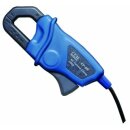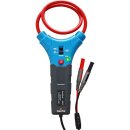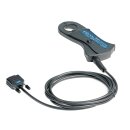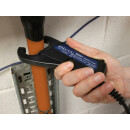
-
: 11 - 13 Workdays (DE - int. shipments may differ)
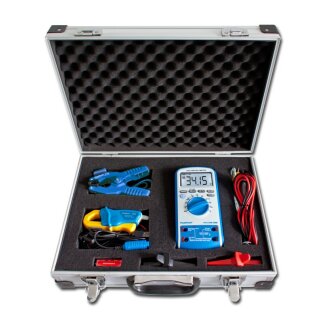
-
: 6 - 8 Workdays (DE - int. shipments may differ)

-
: 1 - 3 Workdays (DE - int. shipments may differ)
- SKU:
- TA018
- SKU:
- TA138
- SKU:
- P8100
| PeakTech 3415: | True RMS Multimeter with USB Interface |
| PeakTech 4200: | Current Clamp Adapter |
| PeakTech TF-25: | K-Type Temperature Clamp Probe |
| PeakTech 7015: | Alligator Clips |
| PeakTech 7020: | Safety Connection Leads |
| PeakTech 7265: | Carrying Case for measurement Devices |
- SKU:
- P4205
- For conductors with a maximum diameter of 160mm
- Measuring ranges 30/300/3000 A AC switchable
- Flexible measuring coil, closure can be opened on one side
- Measurement in conjunction with an existing multimeter
- 1m connecting cable with 4mm banana plugs
- Touch protection
- SKU:
- PA108
- SKU:
- TA300
- SKU:
- TA301
- SKU:
- TA189
- 30A AC/DC Large Jaw Current Clamp
- large bandwidth: DC to 100kHz
- BNC connector
- closed loop control system for better accuracy
- SKU:
- TA019
- Low–battery indicator
- Zero offset button
- BNC type connectors
- Screened lead for noise suppression
- SKU:
- TA167
Clamp Meters: Functionality, Applications, and Technical Details
Clamp meters are specialized measuring instruments used in electronics and electrical engineering to measure electric currents. They provide a simple, safe, and non-contact method for measuring currents in electrical conductors without interrupting the circuit. This document explains how they work, the different types of clamp meters, their applications, and key technical specifications.
How Clamp Meters Work
Clamp meters utilize the principle of electromagnetic induction to measure electrical current in a conductor. There are two main methods they use:
-
AC Measurement:
- The alternating current (AC) flowing through the conductor generates a magnetic field. A coil inside the clamp meter detects this field and converts it into a proportional electrical voltage.
- This principle is based on Faraday's Law of Induction.
-
DC Measurement:
- For direct current (DC) measurement, a Hall sensor is used. This sensor responds to the constant magnetic field generated by the DC and produces an electrical signal proportional to the current strength.
- This technology enables precise measurement even with constant current.
Types of Clamp Meters
-
Standard Clamp Meters:
- Measure AC current only.
- Simple design and affordable price.
- Commonly used in electrical installation and maintenance.
-
Multifunction Clamp Meters:
- Can measure both AC and DC currents.
- Often equipped with additional features like voltage measurement, resistance measurement, and frequency measurement.
- Ideal for versatile applications.
-
Leakage Current Clamps:
- Designed to measure very small currents (e.g., leakage currents in insulation).
- High sensitivity.
-
Flexible Clamp Meters:
- Feature a flexible coil (e.g., Rogowski coil), which can be wrapped around large or hard-to-reach conductors.
- Ideal for measurements on large busbars.
Technical Details
-
Measurement Range:
- Most clamp meters cover measurement ranges from a few milliamperes (mA) to several thousand amperes (A).
- Flexible clamps or Rogowski coils often have an especially large measurement range (up to 10 kA or more).
-
Accuracy:
- Standard clamp meters typically offer an accuracy of ±2-3%.
- Precision models, particularly for laboratory measurements, have accuracies below ±1%.
-
Resolution:
- Indicates the smallest detectable changes in current, e.g., 0.01 A or 0.001 A.
-
Frequency Range:
- AC clamp meters typically operate within a frequency range of 40 Hz to 400 Hz, which is sufficient for mains power and many industrial applications.
- Specialized devices can measure higher frequencies (e.g., in power electronics).
-
Voltage Resistance:
- Clamp meters are designed for a specific maximum voltage (e.g., 600V or 1000V). This voltage resistance is crucial for user safety.
-
Jaw Opening:
- Indicates the maximum thickness of the conductor that can fit into the clamp. Typical values range between 20 mm and 50 mm, with larger models available.
-
Data Interfaces:
- Modern clamp meters often feature interfaces such as Bluetooth or USB to transfer data to an external device (laptop, smartphone).
Applications
-
Electrical Installation:
- Measurement of power consumption and inspection of wiring in household installations.
-
Industrial Maintenance:
- Monitoring of electric motors, transformers, and other industrial equipment.
- Detecting current leaks or faulty components.
-
Energy Efficiency and Monitoring:
- Analysis of energy consumption and distribution in buildings and facilities.
-
Laboratory and Research:
- Precise measurements in experiments and tests, especially for high-frequency currents.
-
Fault Diagnosis:
- Detection of short circuits, overloads, or asymmetric loads in three-phase systems.
Advantages of Clamp Meters
- Non-contact Measurement: No need to interrupt the circuit.
- Safety: Minimal risk to the user since there is no direct contact with live conductors.
- Flexibility: Suitable for both small and large conductors.
- Multifunctionality: Many models can also measure voltage, resistance, frequency, and capacitance.
Maintenance and Calibration
Regular calibration and maintenance are essential to ensure accurate measurements. Annual calibration is recommended, especially for professional applications.
Clamp meters are essential tools for electricians, engineers, and technicians who require precise and safe measurements. The choice of the right model depends on specific requirements such as measurement range, accuracy, and additional functions.


